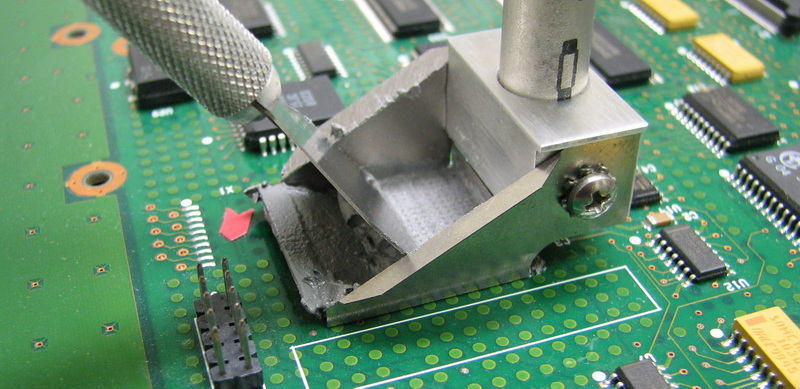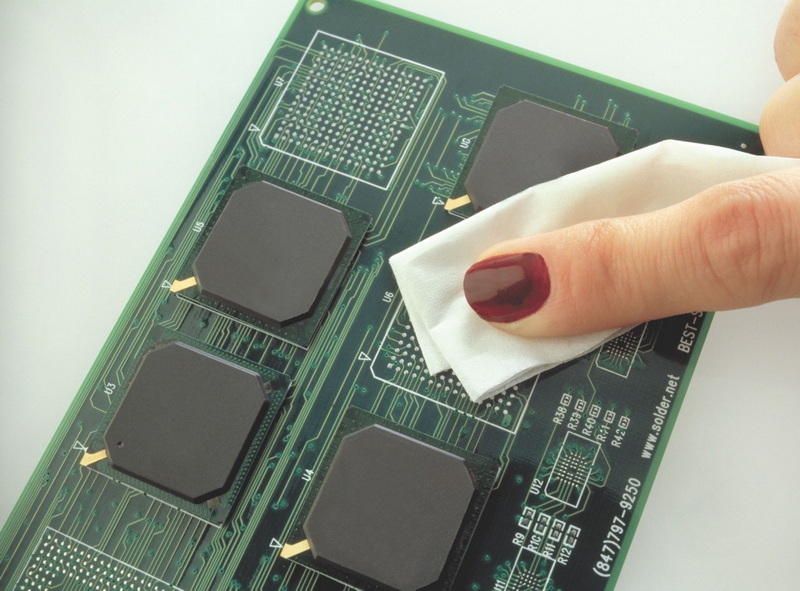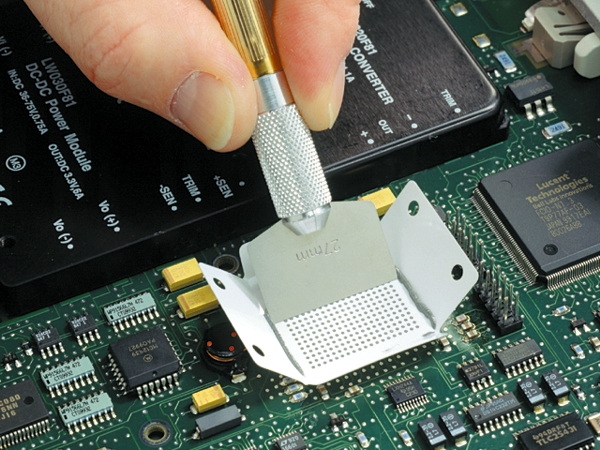Content Menu
● Understanding Mini SMT Stencils
>> Why Mini SMT Stencils Are Essential
● Key Factors for Proper Use of Mini SMT Stencils
>> 1. Selecting the Appropriate Stencil Thickness and Material
>> 2. Designing Apertures for Optimal Performance
>> 3. Maintaining Mini SMT Stencils for Consistent Quality
>> 4. Optimizing Printing Parameters for Mini SMT Stencils
>> 5. Advanced Techniques to Enhance Mini SMT Stencil Performance
● Sourcing Wholesale Mini SMT Stencils
>> Benefits of Buying Wholesale Mini SMT Stencils
>> What to Look for in a Wholesale Mini SMT Stencil Supplier
● Conclusion
● FAQ
>> 1. What is the ideal stencil thickness for mini SMT stencils?
>> 2. How does aperture design affect solder paste printing?
>> 3. Why is stencil cleaning important for mini SMT stencils?
>> 4. What advantages do nano-coated stencils offer?
>> 5. Where can I source high-quality wholesale mini SMT stencils?
Surface Mount Technology (SMT) stencils are indispensable tools in the electronics manufacturing industry, facilitating the precise application of solder paste onto printed circuit boards (PCBs). Among the various types of SMT stencils, mini SMT stencils are specifically designed for small-scale, fine-pitch components, allowing manufacturers to achieve high accuracy and efficiency in PCB assembly. To unlock the full potential of these stencils, it is crucial to understand their proper use, design considerations, maintenance practices, and sourcing strategies, especially when purchasing wholesale mini SMT stencils for large-scale production.

This comprehensive guide will walk you through everything you need to know about using mini SMT stencils effectively to maximize efficiency and quality in your SMT assembly process.
Understanding Mini SMT Stencils
Mini SMT stencils are ultra-thin sheets, typically made from stainless steel or nickel alloys, featuring precisely laser-cut or electroformed apertures that correspond to the solder pads on a PCB. These apertures control the exact amount of solder paste deposited during the printing process, which is critical for ensuring reliable solder joints, especially on small or densely packed components.
Why Mini SMT Stencils Are Essential
- Precision: Mini SMT stencils accommodate extremely fine-pitch components, such as 01005 resistors or micro ball grid arrays (microBGAs), where accuracy is paramount.
- Improved Yield: By delivering consistent solder paste volumes, mini stencils reduce solder bridging, tombstoning, and other defects, leading to higher first-pass yields.
- Cost Efficiency: When purchased in bulk as wholesale mini SMT stencils, manufacturers benefit from reduced costs per unit without compromising quality.
- Flexibility: Mini SMT stencils enable manufacturers to handle complex PCB designs with high component density and fine pitch.
Key Factors for Proper Use of Mini SMT Stencils
1. Selecting the Appropriate Stencil Thickness and Material
The thickness of the stencil foil directly impacts the volume of solder paste deposited. Choosing the right thickness is critical for balancing paste volume with the fine detail required for small components.
- Thickness Range: Mini SMT stencils typically range from approximately 0.05 mm to 0.15 mm in thickness. For ultra-fine pitch components, thinner stencils are preferred to avoid excessive solder paste volume that can cause bridging.
- Material Choices: Stainless steel is the industry standard due to its durability, corrosion resistance, and cost-effectiveness. Nickel alloy stencils, though more expensive, offer superior wear resistance and precision, making them ideal for high-volume production runs.
- Thickness Selection Guidelines: For components with very small pads, a thinner stencil helps maintain a proper aspect ratio (aperture width to stencil thickness) and area ratio (aperture opening area to aperture wall area), which are critical for efficient solder paste release.
2. Designing Apertures for Optimal Performance
The aperture design is fundamental to the stencil's effectiveness. Proper aperture sizing and shaping ensure the right amount of solder paste is deposited without defects.
- Aperture Size Relative to Pad Size: Apertures are often designed to be slightly smaller than the PCB pads to improve gasketing, which prevents solder paste from leaking under the stencil and reduces bridging risks.
- Aperture Shapes: While square and rectangular apertures are common, rounded or trapezoidal apertures can improve solder paste release and reduce the risk of solder balling.
- Aspect and Area Ratios: Maintaining an aspect ratio of at least one and an area ratio above two-thirds is generally recommended to ensure paste releases cleanly from the stencil apertures. These ratios help prevent incomplete paste deposits or smearing.
- Specialized Aperture Designs: For complex or uneven pad layouts, stepped or tapered apertures can be used to fine-tune paste volume and improve solder joint reliability.
3. Maintaining Mini SMT Stencils for Consistent Quality
Regular maintenance and cleaning of mini SMT stencils are essential to maintain print quality and extend stencil lifespan.
- Cleaning Frequency: Solder paste residue can quickly clog apertures, especially in fine-pitch stencils. Cleaning should be performed frequently during production runs using appropriate solvents, ultrasonic cleaning, or automated stencil cleaning machines.
- Inspection: Use magnification tools or automated optical inspection systems to detect clogged or damaged apertures. Early detection prevents defective prints and costly rework.
- Storage Practices: Stencils should be stored in a clean, dry environment, preferably in protective cases or covers to prevent physical damage and contamination.
- Handling: Proper handling with gloves and avoiding bending or scratching the stencil surface preserves aperture integrity.

4. Optimizing Printing Parameters for Mini SMT Stencils
The printing process itself must be carefully controlled to maximize the efficiency and accuracy of solder paste application.
- Squeegee Pressure: Use the minimum pressure necessary to transfer solder paste through the stencil apertures without damaging the stencil or PCB. Excessive pressure can deform the stencil or cause smearing.
- Printing Speed: A balanced printing speed ensures consistent paste deposition. Too fast can cause incomplete fills, while too slow reduces throughput.
- Paste Bead Size: The solder paste bead should be large enough to maintain a consistent roll across the stencil surface, ensuring uniform paste volume in each aperture.
- Vacuum Support and Clamping: Utilizing vacuum tables and foil-less clamping systems helps secure the stencil and PCB during printing, preventing movement and misalignment.
- Environmental Conditions: Temperature and humidity affect solder paste viscosity and stencil performance. Maintaining stable environmental conditions optimizes print quality.
5. Advanced Techniques to Enhance Mini SMT Stencil Performance
Manufacturers looking to push the boundaries of SMT assembly quality and efficiency can consider advanced stencil technologies and treatments.
- Nano-Coating: Applying a hydrophobic nano-coating to the stencil surface reduces solder paste sticking, improving paste release and reducing cleaning frequency. This coating also extends stencil life.
- Electropolishing: This process smooths the aperture walls, reducing roughness and improving solder paste release consistency, particularly important for ultra-fine pitch components.
- Laser Cutting vs. Electroforming: Laser-cut stencils offer quick turnaround and flexibility, while electroformed stencils provide superior aperture quality and durability for high-volume production.
- Custom Aperture Modifications: For challenging PCB layouts, custom aperture shapes such as stepped or trapezoidal designs optimize solder paste volume and improve joint reliability.
Sourcing Wholesale Mini SMT Stencils
For manufacturers aiming to scale production or reduce costs, sourcing wholesale mini SMT stencils is an effective strategy.
Benefits of Buying Wholesale Mini SMT Stencils
- Cost Efficiency: Bulk purchasing reduces the per-unit cost, making it economical for high-volume production.
- Consistent Quality: Wholesale suppliers often maintain strict quality control, ensuring uniformity across stencil batches.
- Wide Selection: Wholesale suppliers typically offer a variety of stencil thicknesses, materials, and customization options.
- Technical Support: Reputable wholesale providers offer design assistance, inspection services, and after-sales support.
What to Look for in a Wholesale Mini SMT Stencil Supplier
- Material and Manufacturing Capabilities: Ensure the supplier can produce stencils in stainless steel and nickel alloys with precise laser cutting or electroforming.
- Customization Services: Ability to customize stencil thickness, aperture design, and size according to your PCB requirements.
- Quality Certifications: Look for suppliers adhering to industry standards such as ISO certifications and providing inspection reports.
- Lead Time and Delivery: Reliable suppliers offer timely delivery to keep your production schedules on track.
- Customer Reviews and References: Positive feedback from other electronics manufacturers indicates trustworthy service.
Conclusion
Mastering the proper use of mini SMT stencils is essential for maximizing efficiency and quality in modern PCB assembly. By carefully selecting stencil thickness and materials, designing precise apertures, maintaining cleanliness, and optimizing printing parameters, manufacturers can achieve superior solder paste deposition and reduce defects. Incorporating advanced treatments like nano-coatings and electropolishing further enhances stencil performance, especially for fine-pitch and miniaturized components.
Moreover, sourcing wholesale mini SMT stencils offers a cost-effective solution for high-volume production, ensuring consistent quality and availability. Whether you are a small electronics manufacturer or a large-scale assembler, understanding and implementing these best practices will lead to improved yields, lower costs, and greater customer satisfaction.

FAQ
1. What is the ideal stencil thickness for mini SMT stencils?
The ideal thickness typically ranges from approximately 0.05 mm to 0.15 mm. Thinner stencils are preferred for ultra-fine pitch components to maintain proper aspect and area ratios, which are critical for efficient solder paste release and minimizing defects.
2. How does aperture design affect solder paste printing?
Aperture size and shape directly influence the volume and consistency of solder paste deposited onto PCB pads. Apertures slightly smaller than pad sizes improve gasketing and reduce solder bridging, while rounded apertures enhance paste release and reduce the risk of solder balls.
3. Why is stencil cleaning important for mini SMT stencils?
Regular cleaning prevents solder paste residue buildup that can clog apertures, causing inconsistent paste deposition and defects. Proper cleaning extends stencil life, maintains print quality, and reduces downtime during production.
4. What advantages do nano-coated stencils offer?
Nano-coatings make the stencil surface more hydrophobic, improving solder paste release, reducing cleaning frequency, and enhancing transfer efficiency. This is especially beneficial for stencils with fine apertures and for high-volume production environments.
5. Where can I source high-quality wholesale mini SMT stencils?
Wholesale mini SMT stencils are available from specialized manufacturers and suppliers offering stainless steel and nickel alloy stencils with customization options. Choose suppliers with industry certifications, quality assurance processes, and positive customer feedback to ensure reliable products.




















